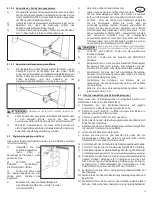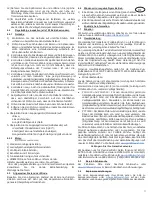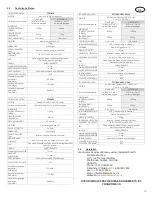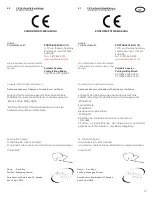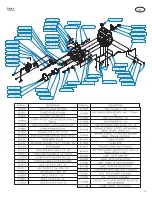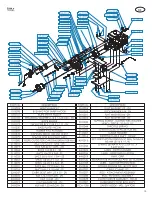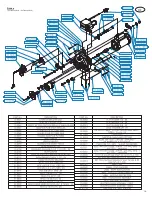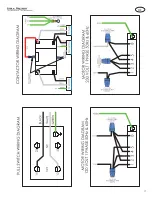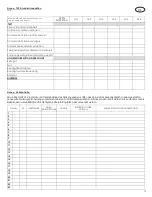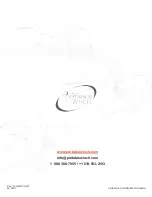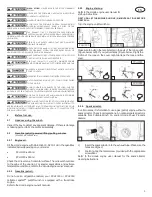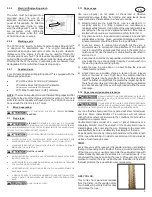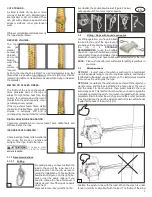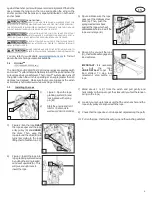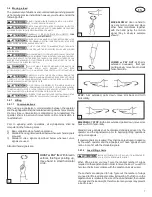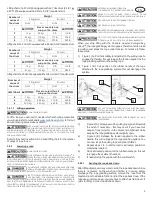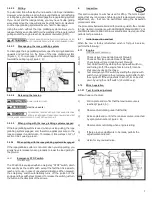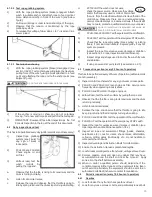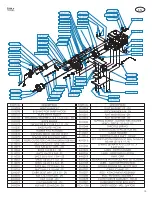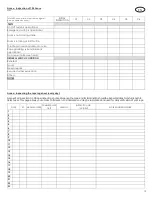
EN
2.2.5
Electric lifting/pulling winch
(PCT1800 only)
The winch must be plugged into a
grounded plug. The use of an
extension cord can cause a loss of
power at full capacity. As listed on
the product label (figure 1), make
sure the voltage and current
type
are
respected.
Units
115V-60hz
require 20 amps while the units
220V-50hz require 10 amps.
2.2.6
Working cycle
The PCT1800 AC Electric Portable Capstan Pulling/Lifting Winch
TM
is
designed for intermittent use.
The engine
manufacturer
recommends an engine duty cycle of 25%. So, to get a maximum
lifetime out of the engine, it should only be used for fifteen (15)
minutes period every hour. This data varies depending on the loads
pulled or lifted. Light loads can be lifted or pulled continuously without
affecting the life of the engine. Continuous pulls are however less
damageable for the motor than frequents stop and go.
2.2.7
Capstan drum.
Your Portable Capstan Pulling/Lifting Winch
TM
is equipped with the
following capstan drum:
●
PCH1000•: Drum 57 mm (2-1/4") diameter.
●
PCH2000•: Drum 108 mm (4-1/4") diameter.
Only drum you can use with PCH2000 winch
●
PCT1800•: Drum 85 mm (3-3/8") diameter.
NOTE :
The maximum pulling force and the rated lifting capacity differ
according to the size of the drum used. Refer to section 5.5 Technical
Data to know the capacity with each drum. The PCH2000 can only
be used with the 108 mm (4-1/2") drum.
3.
Winch operation.
MOST
WINCHING
SITUATIONS
PRESENT
POTENTIAL
DANGERS
!
3.1
Rope type.
USE ONLY
LOW STRETCH 12 OR 13 MM (1/2'') DIAMETER
PORTABLE WINCH CO. DOUBLE BRAIDED POLYESTER ROPE
WITH A MINIMAL BREAKING POINT OF 3150 KG (6945 LB) WITH THIS WINCH. PLEASE
CONTACT US FOR OTHER ROPE TYPE'S SUITABILITY.
DO NOT USE 3-STRAND POLYPROPYLENE YELLOW ROPE!
●
POLYPROPYLENE AND POLYETHYLENE ROPES ARE DANGEROUS FOR
WINCHING BECAUSE OF THEIR GREAT ELASTICITY AND LOW MELT POINT.
●
MAKE SURE THE ROPE IS NOT DAMAGED AND THAT IT OFFERS AN ADEQUATE
RESISTANCE TO PULL THE LOAD.
STRETCH = DANGER!
●
A STRETCHED ROPE CAN RECOIL AND CAUSE SERIOUS BURNS AS THE ROPE
LEAVES YOUR HAND.
●
ALL ROPES STRETCH: A LONGER ONE MORE THAN A SHORTER ONE. THE MORE
YOU PULL, THE MORE IT STRETCHES.
●
A STRETCHED ROPE CAN ALSO MOVE THE LOAD IN AN UNPREDICTABLE OR
DANGEROUS WAY.
●
A STRETCHED ROPE CAN RECOIL AND BRING YOUR HAND TOWARDS THE
WINCH CAUSING SEVERE INJURIES. NEVER WRAP THE ROPE AROUND YOUR
HAND.
ALWAYS WEAR GLOVES.
3.1.1 Rope usage
Use rope properly; do not abuse or shock load it. Observe
recommended usage factors for bending and work loads. Keep
ropes clean and eliminate abrasion whenever possible.
1)
Working loads are the loads that a rope is subjected to in
everyday activity. For lifting purposes we recommend a
minimum safety factor of 7 (app. 15% of the rope minimum break
strength) when the rope has a spliced termination. If the rope is
knotted with a bowline, we recommend a safety factor of 10.
2)
Any sharp bend in a rope under load decreases rope strength
substantially and may cause permanent damage and failure.
Sheave diameters should be 8 times the rope diameter.
3)
Knots are known to reduce rope strength but they are a
convenient way to accomplish rope attachment. The strength
loss is a result of the sharp bends that occur in the knots. If you
must use a knot, use the bowline or double bowline described in
section 3.1.3.
4)
Keep rope clean and as dry as possible. Grit and dirt will work its
way inside the rope and degrade it rapidly. You can wash it in
the washing machine and hang to dry.
5)
Store the rope in a rope bag or in a pail. Coiling the rope will
induce twists and knots.
6)
Shock loads are a sudden change in tension from a relaxed
state or low load to one of high load. Any sudden load that
exceeds the work load by more than 10% is considered a shock
load. The further an object falls, the greater the impact. Synthetic
fibers have a memory and retain the effects of being overloaded
and can fail at a later time even though loaded within the work
load range.
3.1.2 Rope inspection and maintenance
VISUALLY INSPECT YOUR ROPE BEFORE EACH USAGE. IF IT
SHOWS ANY SIGN OF DETERIORATION (CUT STRANDS,
EXCESSIVE ABRASION), REPLACE IT.
IF YOUR ROPE IS DIRTY, WASH IT. DIRTY ROPES DETERIORATE
FASTER AND CAUSE PREMATURE WEAR OF THE PARTS IN
CONTACT WITH THE ROPE SUCH AS THE CAPSTAN DRUM AND ROPE GUIDE.
Any rope that has been used for any period will show normal wear
and tear. Some characteristics of a used rope will not reduce
strength while others will. Below are the conditions that should be
inspected on a regular basis.
Double braid ropes consist of a cover or jacket braided over a
separately braided core. The strength of the double braid rope is
shared between the cover and the core. Damage to the cover also
usually affects the core and ultimately the strength of the rope.
Rope inspection is done by running both hands over the entire length
of the rope while turning it in order to see all around. It is a visual as
well as a touch feeling process.
TWIST :
Every time you set the rope over the capstan drum you are twisting
the rope. Depending on the length of the rope, and what percentage
of the rope you use, you will sooner or later have a twisted rope with
reduced capacity because the strands are not loaded evenly. You
can un-twist the rope by spinning the rope to a free end. It is a good
practice to reverse the rope - use both ends. In addition to help with
the twist problem, the rope will also wear more evenly.
GREY COLOR :
This comes from aluminium residues
from the friction on the capstan drum.
Your hands will get dirty but this does
not damage the rope.
4
Summary of Contents for PCH1000
Page 14: ...14 DE Annex PCH1000 ...
Page 15: ...15 DE Annex PCH2000 ...
Page 16: ...16 DE Annex PCT1800 50Hz P PCT1800 60Hz P ...
Page 17: ...17 DE Annex Diagramm PCT1800 50Hz P PCT1800 60Hz P ...
Page 34: ...14 EN Annex PCH1000 ...
Page 35: ...15 EN Annex PCH2000 ...
Page 36: ...16 EN Annex PCT1800 50Hz P PCT1800 60Hz P ...
Page 37: ...17 EN Annex diagram PCT1800 50Hz P PCT1800 60Hz P ...
Page 54: ...14 FR Annexe PCH1000 ...
Page 55: ...15 FR Annexe PCH2000 ...
Page 56: ...16 FR Annexe PCT1800 50Hz P PCT1800 60Hz P ...
Page 57: ...17 FR Annexe diagramme PCT1800 50Hz P PCT1800 60Hz P ...

